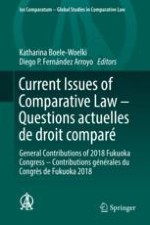2019 | OriginalPaper | Buchkapitel
On the Modes of Confluence in Law
verfasst von : Ko Hasegawa
Erschienen in: Current Issues of Comparative Law – Questions actuelles de droit comparé
Aktivieren Sie unsere intelligente Suche, um passende Fachinhalte oder Patente zu finden.
Wählen Sie Textabschnitte aus um mit Künstlicher Intelligenz passenden Patente zu finden. powered by
Markieren Sie Textabschnitte, um KI-gestützt weitere passende Inhalte zu finden. powered by
